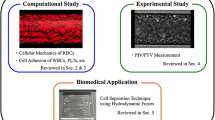Abstract
Malaria-infected red blood cells (IRBCs) show various changes in mechanical properties. IRBCs lose their deformability and develop properties of cytoadherence and rosetting. To clarify how these changes advance microvascular occlusion, we need qualitative and quantitative information on hemodynamics in malaria infection, including the interaction among IRBCs, healthy RBCs, and endothelial cells. We developed a numerical model of blood flow with IRBCs based on conservation laws of fluid dynamics. The deformability and adhesive property of IRBCs were simply modeled using springs governed by Hook’s law. Our model could express the basic behavior of IRBCs, including the rolling motion due to cytoadhesive interaction with endothelial cells and complex interaction with healthy RBCs. We confirmed that these types of interactions significantly increase the flow resistance, particularly when knobs develop.






Similar content being viewed by others
References
Chotivanich K. T., A. M. Dondorp, N. J. White, K. Peters, J. Vreeken, P. A. Kager, R. Udomsangpetch 2000. The resistance to physiological shear stresses of the erythrocytic rosettes formed by cells infected with Plasmodium falciparum. Ann. Trop. Med. Parasitol. 94, 219–226. 10.1080/00034980050006384
Dao M., C. T. Lim, S. Suresh 2003. Mechanics of the human red blood cell deformed by optical tweezers. J. Mech. Phys. Solids 51, 2259–2280. 10.1016/j.jmps.2003.09.019
Dondorp A. M., P. A. Kager, J. Vreeken, N. J. White 2000. Abnormal blood flow and red blood cell deformability in severe malaria. Parasitol. Today 16, 228–232. 10.1016/S0169-4758(00)01666-5
Dzwinel W., K. Boryczko, D. A. Yuen 2003. A discrete-particle model of blood dynamics in capillary vessels. J. Colloid Interface Sci. 258, 163–173. 10.1016/S0021-9797(02)00075-9
Heise M., S. Schmidt, U. Krüger, R. Rückert, S. Rösler, P. Neuhaus, U. Settmacher 2004. Flow pattern and shear stress distribution of distal end-to-side anastomoses. A comparison of the instantaneous velocity fields obtained by particle image velocimetry. J. Biomech. 37, 1043–1051. 10.1016/j.jbiomech.2003.11.030
Ho M., N. J. White 1999. Molecular mechanisms of cytoadherence in malaria. Am. J. Physiol. Cell Physiol. 276, 1231–1242
Jeong J. H., Y. Sugii, M. Minamiyama, H. Takeuchi, K. Okamoto 2007. Interaction between liposomes and RBC in microvessels in vivo. Microvasc. Res. 73, 39–47. 10.1016/j.mvr.2006.05.001
Kaul D. K., E. F. Roth, R. L. Nagel, R. J. Howard, S. M. Handunnetti 1991. Rosetting of Plasmodium falciparum-infected red blood cells with uninfected red blood cells enhances microvascular obstruction under flow conditions. Blood 78, 812–819
Koshizuka S., Y. Oka 1996. Moving-particle semi-implicit method for fragmentation of incompressible fluid. Nucl. Sci. Eng. 123, 421–434
Lima R., S. Wada, S. Tanaka, M. Takeda, T. Ishikawa, K. Tsubota, Y. Imai, T. Yamaguchi 2007. In vitro confocal micro-PIV measurements of blood flow in a square microchannel: the effect of the haematocrit on instantaneous velocity profiles. J. Biomech. 40, 2752–2757. 10.1016/j.jbiomech.2007.01.012
Liu Y., W. K. Liu 2006. Rheology of red blood cell aggregation by computer simulation. J. Comput. Phys. 220, 139–154. 10.1016/j.jcp.2006.05.010
Miller L. H., D. I. Baruch, K. Marsh, O. K. Doumbo 2002. The pathogenic basis of malaria. Nature 415, 673–679. 10.1038/415673a
Miyazaki H., T. Yamaguchi 2003. Formation and destruction of primary thrombi under the influence of blood flow and von Willebrand factor analyzed by a discrete element method. Biorheology 40, 265–272
Mori D., K. Yano, K. Tsubota, T. Ishikawa, S. Wada, T. Yamaguchi (2008) Simulation of platelet adhesion and aggregation regulated by fibrinogen and von Willebrand factor. Thromb. Haemost. 99(1):108–115
Nagao E., O. Kaneko, J. A. Dvorak 2000. Plasmodium falciparum-infected erythrocytes: qualitative and quantitative analyses of parasite-induced knobs by atomic force microscopy. J. Struct. Biol. 130, 34–44. 10.1006/jsbi.2000.4236
Pasloske B. L., R. J. Howard 2000. Malaria, the red cell, and the endothelium. Annu. Rev. Med. 45, 283–295. 10.1146/annurev.med.45.1.283
Shelby J. P., J. White, K. Ganesan, P. K. Rathod, D. T. Chiu 2003. A microfluidic model for single-cell capillary obstruction by Plasmodium falciparum-infected erythrocytes. Proc. Natl. Acad. Sci. USA 100, 14618–14622. 10.1073/pnas.2433968100
Silamut K., N. H. Phu, C. Whitty, G. D. H. Turner, K. Louwrier, N. T. H. Mai, J. A. Simpson, T. T. Hien, N. J. White 1999. A quantitative analysis of the microvascular sequestration of malaria parasites in the human brain. Am. J. Pathol. 155, 395–410
Suresh S., J. Spatz, J. P. Mills, A. Micoulet, M. Dao, C. T. Lim, M. Beil, T. Seufferlein 2005. Connection between single-cell biomechanics and human disease states: gastrointestinal cancer and malaria. Acta Biomater. 1, 15–30. 10.1016/j.actbio.2004.09.001
Tsubota K., S. Wada, T. Yamaguchi 2006. Particle method for computer simulation of red blood cell motion in blood flow. Comput. Methods Programs Biomed. 83, 139–146. 10.1016/j.cmpb.2006.06.005
Tsubota K., S. Wada, T. Yamaguchi 2006. Simulation study on effects of hematocrit on blood flow properties using particle method. J. Biomech. Sci. Eng. 1, 159–170. 10.1299/jbse.1.159
Wada S., R. Kobayashi 2003. Numerical simulation of various shape changes of a swollen red blood cell by decrease of its volume. Trans. JSME 69A:14–21 (in Japanese)
Yipp B. G., S. Anand, T. Schollaardt, K. D. Patel, S. Looareesuwan, M. Ho 2000. Synergism of multiple adhesion molecules in mediating cytoadherence of Plasmodium falciparum-infected erythrocytes to microvascular endothelial cells under flow. Blood 96, 2292–2298
Acknowledgments
This study was made possible by the following grants: the “Revolutionary Simulation Software (RSS21)” project, supported by the next-generation IT program of the Ministry of Education, Culture, Sports, Science and Technology (MEXT), Grants-in-Aid for Scientific Research from MEXT, and JSPS Scientific Research in Priority Areas (768) “Biomechanics at Micro- and Nano-scale Levels” and Scientific Research(A) No.16200031 “Mechanism of the Formation, Destruction, and Movement of Thrombi Responsible for Ischemia of Vital Organs”.
Author information
Authors and Affiliations
Corresponding author
Rights and permissions
About this article
Cite this article
Kondo, H., Imai, Y., Ishikawa, T. et al. Hemodynamic Analysis of Microcirculation in Malaria Infection. Ann Biomed Eng 37, 702–709 (2009). https://doi.org/10.1007/s10439-009-9641-1
Received:
Accepted:
Published:
Issue Date:
DOI: https://doi.org/10.1007/s10439-009-9641-1




